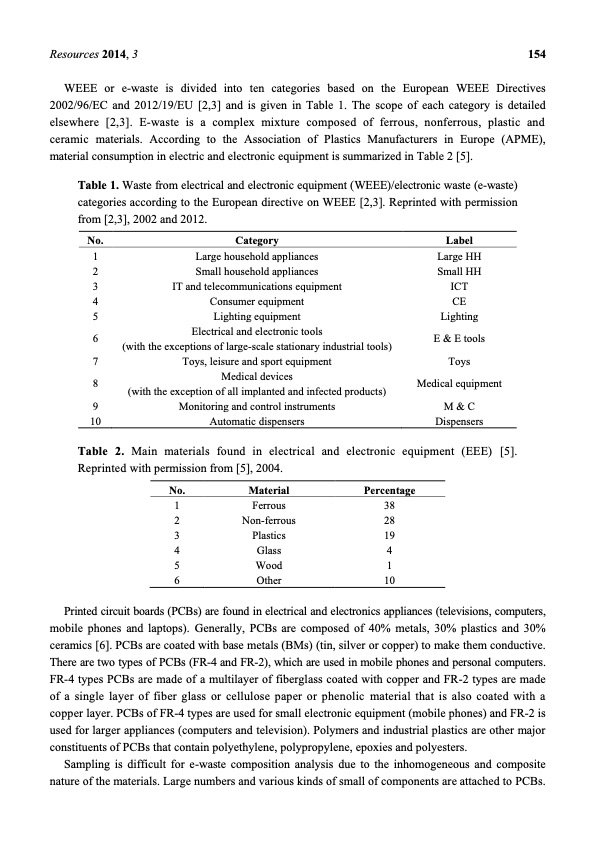
PDF Publication Title:
Text from PDF Page: 003
Resources 2014, 3 154 WEEE or e-waste is divided into ten categories based on the European WEEE Directives 2002/96/EC and 2012/19/EU [2,3] and is given in Table 1. The scope of each category is detailed elsewhere [2,3]. E-waste is a complex mixture composed of ferrous, nonferrous, plastic and ceramic materials. According to the Association of Plastics Manufacturers in Europe (APME), material consumption in electric and electronic equipment is summarized in Table 2 [5]. Table 1. Waste from electrical and electronic equipment (WEEE)/electronic waste (e-waste) categories according to the European directive on WEEE [2,3]. Reprinted with permission from [2,3], 2002 and 2012. No. 1 2 3 4 5 6 7 8 9 10 Category Large household appliances Small household appliances IT and telecommunications equipment Consumer equipment Lighting equipment Electrical and electronic tools (with the exceptions of large-scale stationary industrial tools) Toys, leisure and sport equipment Medical devices (with the exception of all implanted and infected products) Monitoring and control instruments Automatic dispensers Label Large HH Small HH ICT CE Lighting E & E tools Toys Medical equipment M & C Dispensers Table 2. Main materials found in electrical and electronic equipment (EEE) [5]. Reprinted with permission from [5], 2004. No. 1 2 3 4 5 6 Material Percentage Ferrous 38 Non-ferrous 28 Plastics 19 Glass 4 Wood 1 Other 10 Printed circuit boards (PCBs) are found in electrical and electronics appliances (televisions, computers, mobile phones and laptops). Generally, PCBs are composed of 40% metals, 30% plastics and 30% ceramics [6]. PCBs are coated with base metals (BMs) (tin, silver or copper) to make them conductive. There are two types of PCBs (FR-4 and FR-2), which are used in mobile phones and personal computers. FR-4 types PCBs are made of a multilayer of fiberglass coated with copper and FR-2 types are made of a single layer of fiber glass or cellulose paper or phenolic material that is also coated with a copper layer. PCBs of FR-4 types are used for small electronic equipment (mobile phones) and FR-2 is used for larger appliances (computers and television). Polymers and industrial plastics are other major constituents of PCBs that contain polyethylene, polypropylene, epoxies and polyesters. Sampling is difficult for e-waste composition analysis due to the inhomogeneous and composite nature of the materials. Large numbers and various kinds of small of components are attached to PCBs.PDF Image | Metal Extraction Processes for Electronic Waste

PDF Search Title:
Metal Extraction Processes for Electronic WasteOriginal File Name Searched:
resources-03-00152.pdfDIY PDF Search: Google It | Yahoo | Bing
NFT (Non Fungible Token): Buy our tech, design, development or system NFT and become part of our tech NFT network... More Info
IT XR Project Redstone NFT Available for Sale: NFT for high tech turbine design with one part 3D printed counter-rotating energy turbine. Be part of the future with this NFT. Can be bought and sold but only one design NFT exists. Royalties go to the developer (Infinity) to keep enhancing design and applications... More Info
Infinity Turbine IT XR Project Redstone Design: NFT for sale... NFT for high tech turbine design with one part 3D printed counter-rotating energy turbine. Includes all rights to this turbine design, including license for Fluid Handling Block I and II for the turbine assembly and housing. The NFT includes the blueprints (cad/cam), revenue streams, and all future development of the IT XR Project Redstone... More Info
Infinity Turbine ROT Radial Outflow Turbine 24 Design and Worldwide Rights: NFT for sale... NFT for the ROT 24 energy turbine. Be part of the future with this NFT. This design can be bought and sold but only one design NFT exists. You may manufacture the unit, or get the revenues from its sale from Infinity Turbine. Royalties go to the developer (Infinity) to keep enhancing design and applications... More Info
Infinity Supercritical CO2 10 Liter Extractor Design and Worldwide Rights: The Infinity Supercritical 10L CO2 extractor is for botanical oil extraction, which is rich in terpenes and can produce shelf ready full spectrum oil. With over 5 years of development, this industry leader mature extractor machine has been sold since 2015 and is part of many profitable businesses. The process can also be used for electrowinning, e-waste recycling, and lithium battery recycling, gold mining electronic wastes, precious metals. CO2 can also be used in a reverse fuel cell with nafion to make a gas-to-liquids fuel, such as methanol, ethanol and butanol or ethylene. Supercritical CO2 has also been used for treating nafion to make it more effective catalyst. This NFT is for the purchase of worldwide rights which includes the design. More Info
NFT (Non Fungible Token): Buy our tech, design, development or system NFT and become part of our tech NFT network... More Info
Infinity Turbine Products: Special for this month, any plans are $10,000 for complete Cad/Cam blueprints. License is for one build. Try before you buy a production license. May pay by Bitcoin or other Crypto. Products Page... More Info
| CONTACT TEL: 608-238-6001 Email: greg@infinityturbine.com | RSS | AMP |